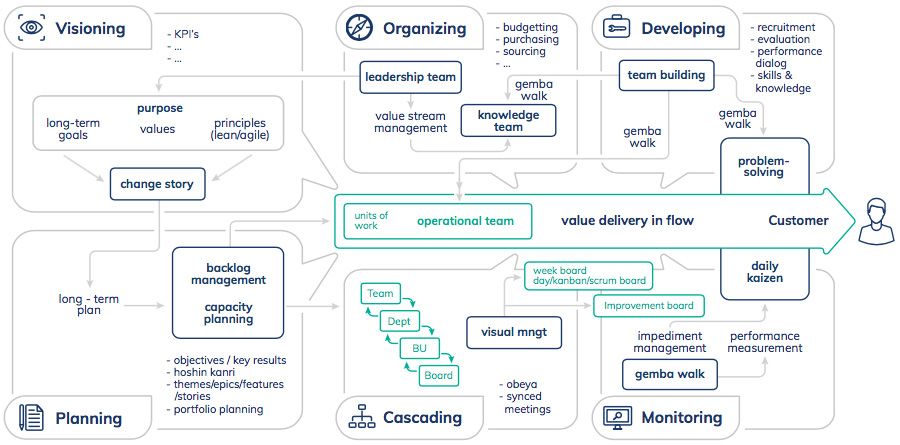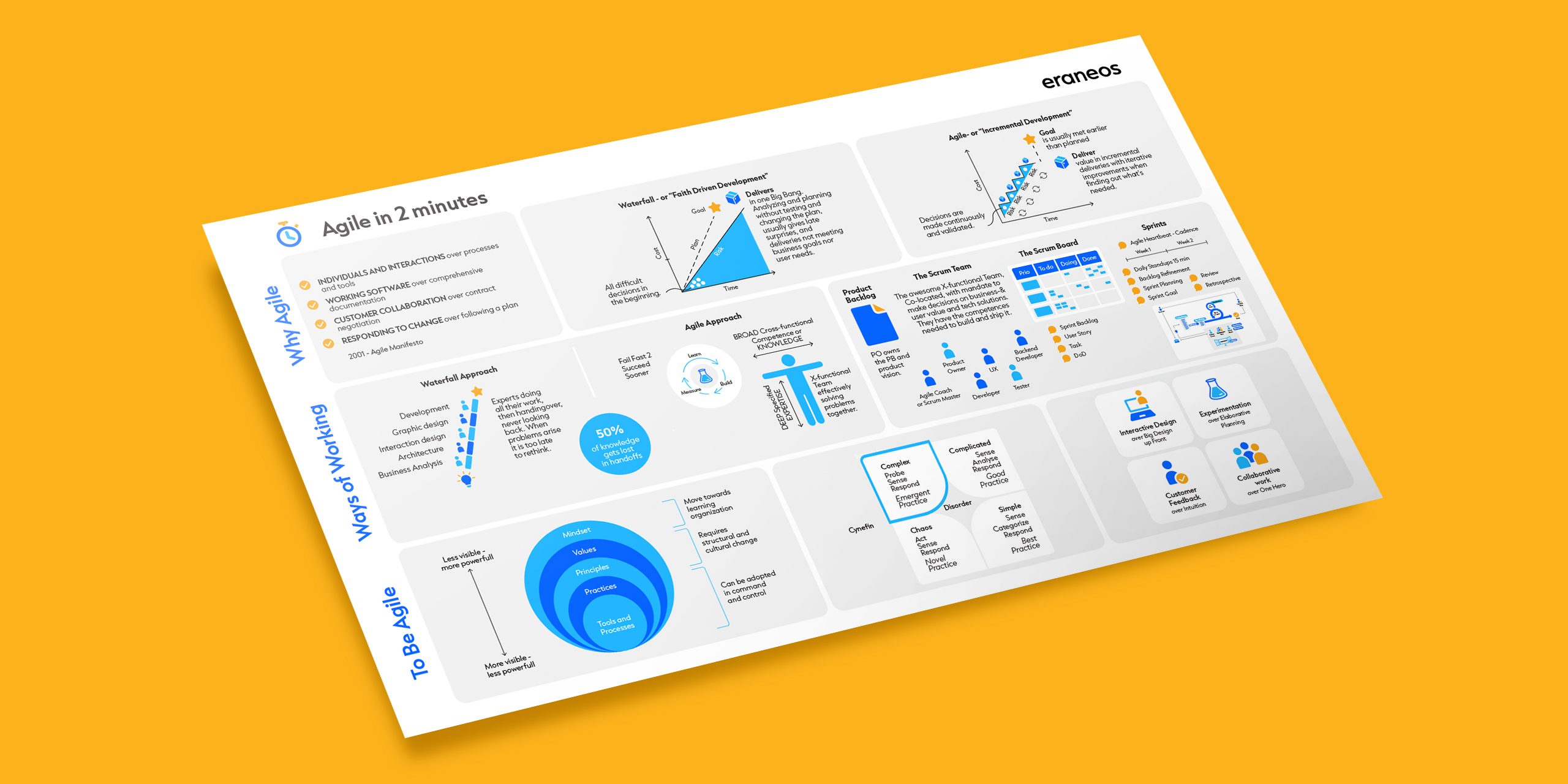Agile working methods have become hugely popular in the last two decades, with more than eight in every ten companies in Western Europe currently working to adopt such practices. The whitepaper from Eraneos highlights the six key factors leaders need to pay attention to in order to foster successful Agile transformations in their companies.
Agile is a way of working that emerged out of a growing dissatisfaction with IT techniques used in the late 90s, such as the waterfall method in software development. The approach puts speed and autonomy at its core, advocating a process characterised by the division of tasks into short phases of work and frequent reassessment and adaptation of plans. Since the launch of the Agile Manifesto in 2001, the approach gained popularity well beyond the IT experts it was initially intended for, with a study by Wemanity recently finding 83% of large corporates in Western Europe are adopting Agile.
Taking up Agile working is easier said than done, however, as it means adopting a mind-set of continuous improvement, creating time for people to innovate, and encouraging a culture of collaboration and empowerment to support that innovation. As a result, management must drive the Agile transformation if it is to succeed, with senior teams being able to communicate the strategy and demonstrate that they themselves are becoming Agile. Without this, companies will falter and ultimately return to old ways of working.
Eraneos (previously Quint) is an international consulting, training and technology firm that supports clients in designing and operationalising their digital transformations, and adopting Agile working. According to a new study from the Netherlands-based firm, if an Agile transformation is to succeed, business leaders must adhere to six key factors.

1. Organizing
The report finds that most organisations are already structured in the form of an organisational chart, but in a Lean-Agile organisation, this needs to shift to multidisciplinary teams made up of multi-skilled team members, with a clearly defined scope of responsibility linked to a clearly defined set of customers. Before this change occurs, however, Eraneos’ study asserts that leaders need to first secure the provision of capital, personnel and raw materials for the day-to-day running of the organisation. With this base in place, companies can then focus on building a structure to match the work they are executing.
“Leaders must create an organisational structure in which the dependencies between teams are reduced to an absolute minimum, creating ‘autonomous’ teams. In more traditional organisations, the organisational chart comprises groups of people who work on the same subject matter, so finance people sit with finance people, marketeers with marketeers, IT people with other IT people and so on.”
2. Visioning
Loader continued, “Assuming we have an existing situation in which people are organised in some form of structure through which value is delivered to customers, however inefficiently, it is now up to leadership to create the story for the direction of the organisation, known as ‘visioning’.” The report elaborates that in a Lean-Agile organisation, a company’s ‘direction’ is described in the form of a ‘purpose’. Formulated by each team in the organisation, based on the purpose as described by the board, this common purpose is turned into an ‘individual change story’ by each leader, explaining why the individual leader is committed to the direction, and aims to inspire their team to move in that direction. The change story should also be used as the basis for the company’s long-term Agile plan.
3. Planning
Central to an Agile transformation, as well as making an organisation Lean, is the drawing up plans of actions that combine unity, continuity, flexibility and precision according to the organisation’s resources and variety. Prioritising work and therefore coordinating it on different levels with different time horizons is central to this. “Leaders must create a long-term plan for where they wish the organisation to go,” Loader unpacked. “This five to ten-year plan is translated to a medium-term plan for the next 12-18 months. Interestingly, many leaders say that it is impossible to make a five to ten-year plan for the organisation because the world is changing so fast. This is true if the plan consists of detailed descriptions of the technological changes that need to take place. But the long-term plan must be based on the achievement of the purpose of the organisation, rather than interim tactical goals.”
4. Cascading
“Cascading is about ensuring that communication flows through the organisation,” Loader said. “The cascade is used to communicate and gain input regarding the strategic choices of the organisation. In this respect, the cascade is a vital and complementary aspect of planning. The cascade is also used to ensure that work is coordinated across the organisation, and that work being carried out by multiple teams is done at the right time to ensure that the result is delivered in flow to the customer.” The white paper contends that there are three topics that are of particular interest for this process. These are strategic choices, impediments and coordination of work. Companies should take note that communication flows should be rapid and capable of moving in both directions between teams and senior management, ensuring unification and a harmony of activities between the organisation’s activities, as well as active prioritisation of goals.
5. Monitoring
Identifying weaknesses and errors by managing feedback, and conforming activities with plans, policies and instructions is essential to a successful transformation. Without being able to identify and celebrate the successes of the organisation as it moves toward Lean-Agile working, morale risks falling, while areas where improvement is needed risk being overlooked. A keystone practice of this is the ‘gemba walk’ (from the Japanese ‘gemba’ meaning “the actual place”), where staff to stand back from their day-to-day tasks to walk the floor of their workplace to identify wasteful activities. Loader expanded, “Leaders must at least do two things when doing a gemba walk. The first is to be curious regarding performance, both qualitative and quantitative. ‘Curious’ in the sense that leaders must be truly interested in the performance and must be prepared to, respectfully, ask questions… Based on these questions and answers, leaders can help to remove impediments to the flow of work, especially when there are policy choices causing the problems. This is the second reason for the gemba walk: impediment management.”
6. Developing
Finally, the paper asserts that leaders must be able to help the teams with problem-solving; not by giving answers but by helping with the structured problem-solving method that will help to reach a high-quality solution. This means recruiting, hiring and training team members who can boost Agile culture, while maintaining favourable working conditions. Leaders and team members must also ensure they continue to meet the requirements of the organisation. “In order to develop a high-performance organisation, leaders must be capable of building and helping to build teams,” Loader concluded. “It is within teams that people can find the safety to experiment and practice, thereby building new skills and knowledge. This is a subsection of the team-building keystone practice. This links into the need to observe, understand and drive the evolution of behaviors in the team. Carrying out performance dialogs is part of creating a culture in which rapid feedback ensures that quality is embedded at the source of the work.”




